ACCT6004 Case Study: Management Accounting Cost Analysis and Solutions
VerifiedAdded on 2022/09/13
|7
|1173
|11
Case Study
AI Summary
This document presents a comprehensive solution to a management accounting case study, focusing on cost analysis and overhead allocation. The case study examines a scenario involving a manufacturing process, where the predetermined overhead rate is a key aspect. The solution addresses questions related to the calculation of overhead rates, total cost of production, and the impact of introducing new machinery on these costs. It includes detailed calculations of revised overhead rates, considering changes in labor hours and additional costs. The analysis also delves into the significance of overhead costs, comparing different scenarios of labor savings and their effect on overall costs. The document provides recommendations based on the cost analysis, including a discussion on whether to invest in new machinery based on potential cost savings. References and bibliography are included, supporting the analysis and findings. The solution demonstrates the application of cost accounting techniques and their role in managerial decision-making.
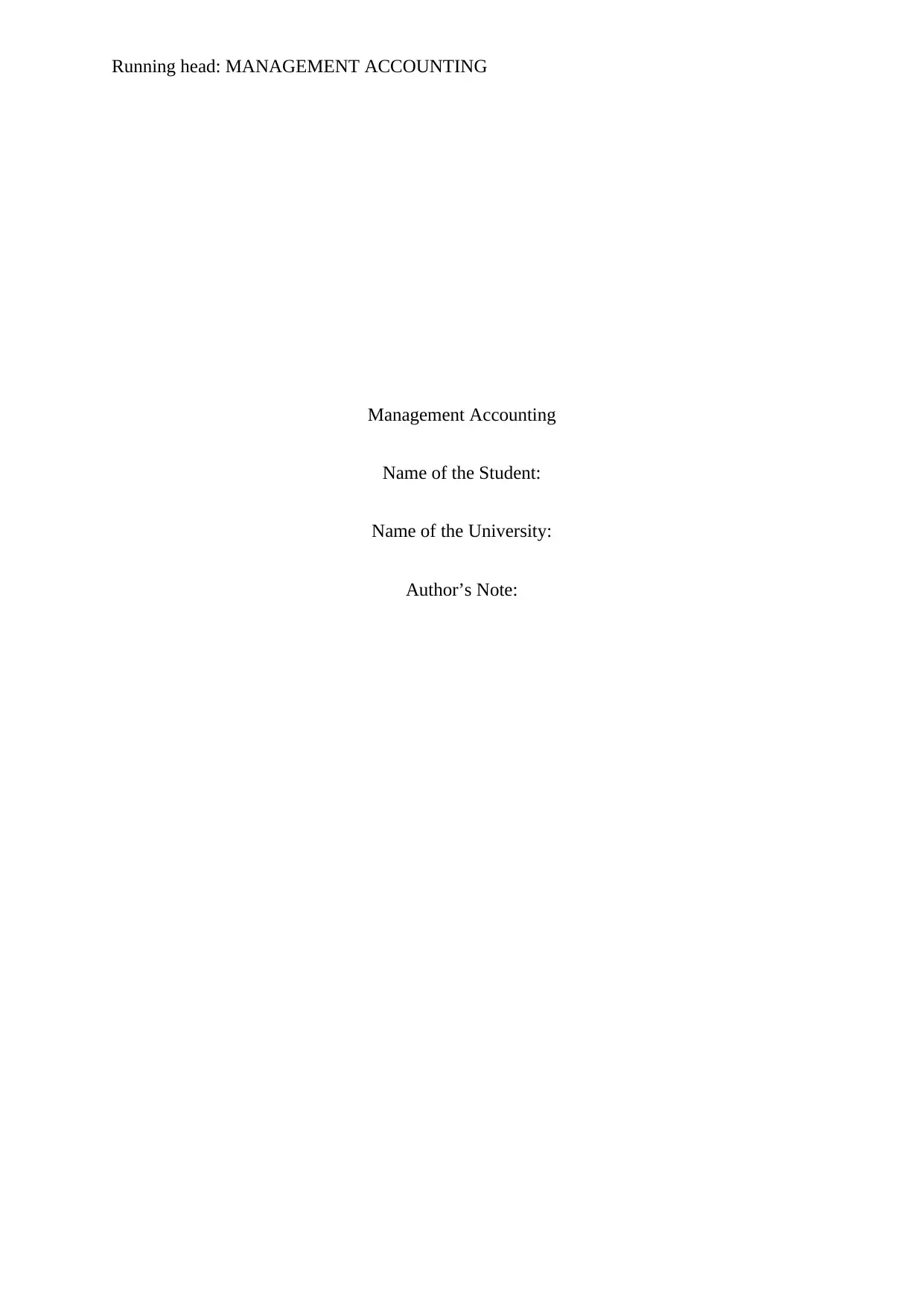
Running head: MANAGEMENT ACCOUNTING
Management Accounting
Name of the Student:
Name of the University:
Author’s Note:
Management Accounting
Name of the Student:
Name of the University:
Author’s Note:
Paraphrase This Document
Need a fresh take? Get an instant paraphrase of this document with our AI Paraphraser
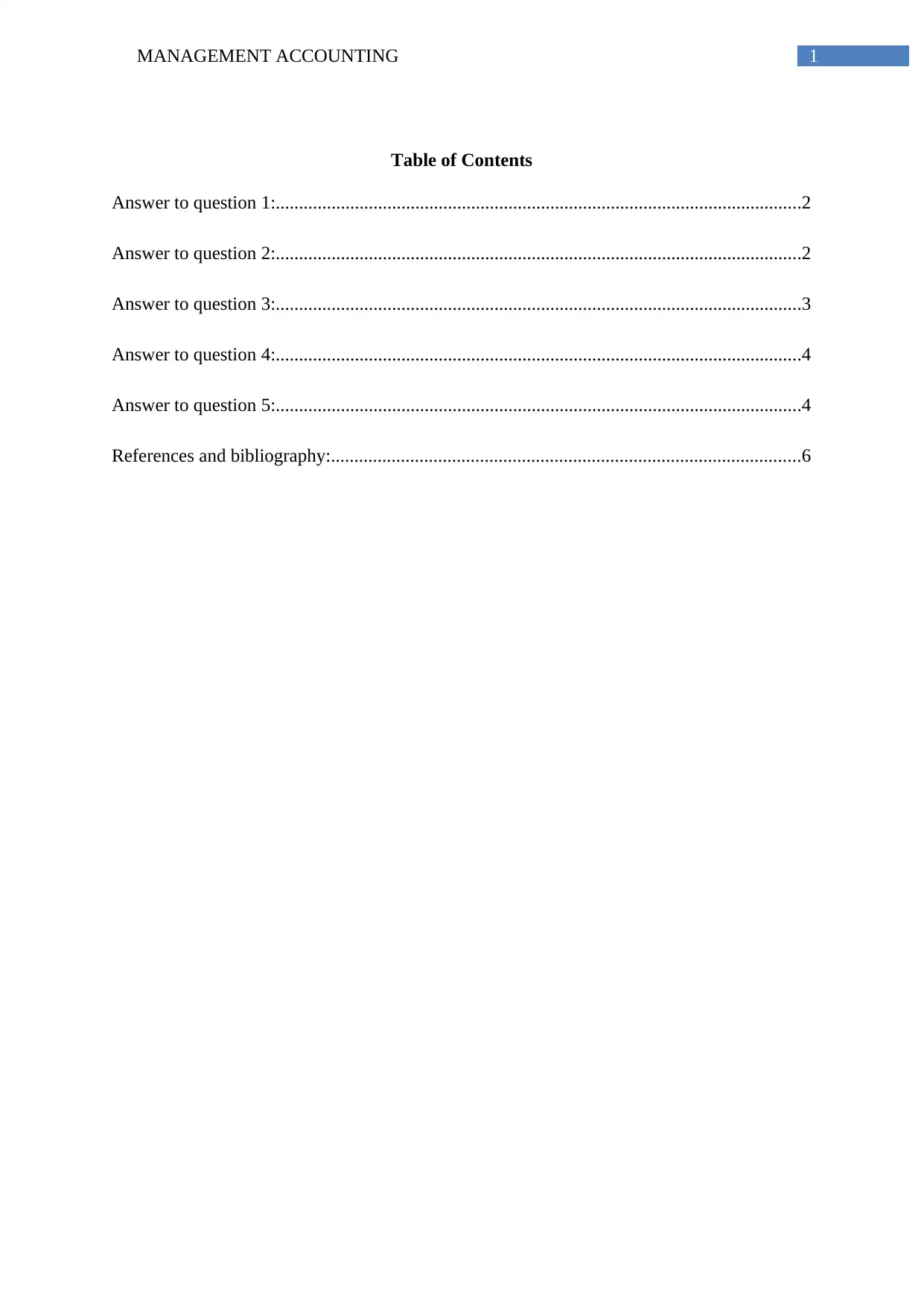
1MANAGEMENT ACCOUNTING
Table of Contents
Answer to question 1:.................................................................................................................2
Answer to question 2:.................................................................................................................2
Answer to question 3:.................................................................................................................3
Answer to question 4:.................................................................................................................4
Answer to question 5:.................................................................................................................4
References and bibliography:.....................................................................................................6
Table of Contents
Answer to question 1:.................................................................................................................2
Answer to question 2:.................................................................................................................2
Answer to question 3:.................................................................................................................3
Answer to question 4:.................................................................................................................4
Answer to question 5:.................................................................................................................4
References and bibliography:.....................................................................................................6
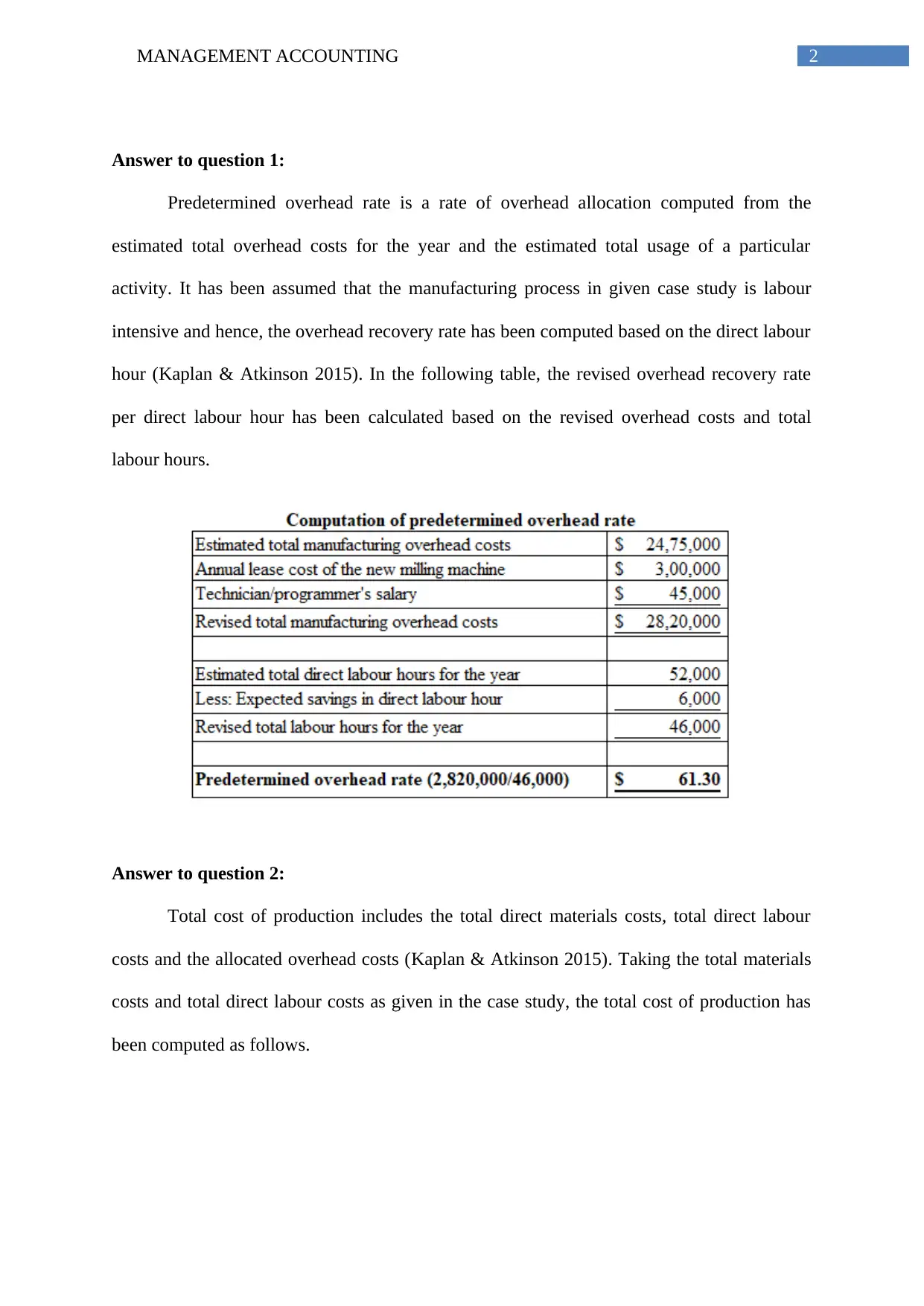
2MANAGEMENT ACCOUNTING
Answer to question 1:
Predetermined overhead rate is a rate of overhead allocation computed from the
estimated total overhead costs for the year and the estimated total usage of a particular
activity. It has been assumed that the manufacturing process in given case study is labour
intensive and hence, the overhead recovery rate has been computed based on the direct labour
hour (Kaplan & Atkinson 2015). In the following table, the revised overhead recovery rate
per direct labour hour has been calculated based on the revised overhead costs and total
labour hours.
Answer to question 2:
Total cost of production includes the total direct materials costs, total direct labour
costs and the allocated overhead costs (Kaplan & Atkinson 2015). Taking the total materials
costs and total direct labour costs as given in the case study, the total cost of production has
been computed as follows.
Answer to question 1:
Predetermined overhead rate is a rate of overhead allocation computed from the
estimated total overhead costs for the year and the estimated total usage of a particular
activity. It has been assumed that the manufacturing process in given case study is labour
intensive and hence, the overhead recovery rate has been computed based on the direct labour
hour (Kaplan & Atkinson 2015). In the following table, the revised overhead recovery rate
per direct labour hour has been calculated based on the revised overhead costs and total
labour hours.
Answer to question 2:
Total cost of production includes the total direct materials costs, total direct labour
costs and the allocated overhead costs (Kaplan & Atkinson 2015). Taking the total materials
costs and total direct labour costs as given in the case study, the total cost of production has
been computed as follows.
⊘ This is a preview!⊘
Do you want full access?
Subscribe today to unlock all pages.

Trusted by 1+ million students worldwide
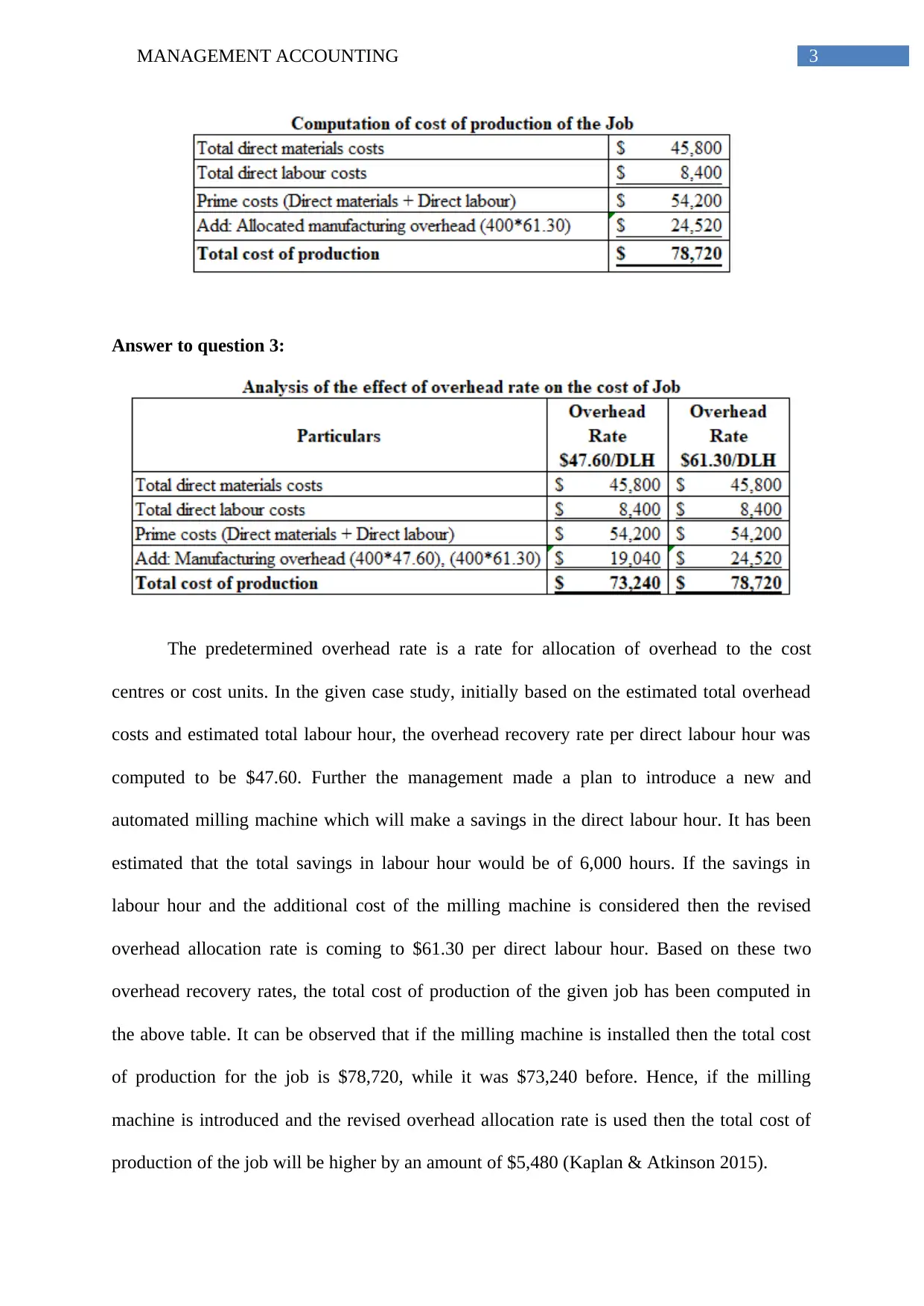
3MANAGEMENT ACCOUNTING
Answer to question 3:
The predetermined overhead rate is a rate for allocation of overhead to the cost
centres or cost units. In the given case study, initially based on the estimated total overhead
costs and estimated total labour hour, the overhead recovery rate per direct labour hour was
computed to be $47.60. Further the management made a plan to introduce a new and
automated milling machine which will make a savings in the direct labour hour. It has been
estimated that the total savings in labour hour would be of 6,000 hours. If the savings in
labour hour and the additional cost of the milling machine is considered then the revised
overhead allocation rate is coming to $61.30 per direct labour hour. Based on these two
overhead recovery rates, the total cost of production of the given job has been computed in
the above table. It can be observed that if the milling machine is installed then the total cost
of production for the job is $78,720, while it was $73,240 before. Hence, if the milling
machine is introduced and the revised overhead allocation rate is used then the total cost of
production of the job will be higher by an amount of $5,480 (Kaplan & Atkinson 2015).
Answer to question 3:
The predetermined overhead rate is a rate for allocation of overhead to the cost
centres or cost units. In the given case study, initially based on the estimated total overhead
costs and estimated total labour hour, the overhead recovery rate per direct labour hour was
computed to be $47.60. Further the management made a plan to introduce a new and
automated milling machine which will make a savings in the direct labour hour. It has been
estimated that the total savings in labour hour would be of 6,000 hours. If the savings in
labour hour and the additional cost of the milling machine is considered then the revised
overhead allocation rate is coming to $61.30 per direct labour hour. Based on these two
overhead recovery rates, the total cost of production of the given job has been computed in
the above table. It can be observed that if the milling machine is installed then the total cost
of production for the job is $78,720, while it was $73,240 before. Hence, if the milling
machine is introduced and the revised overhead allocation rate is used then the total cost of
production of the job will be higher by an amount of $5,480 (Kaplan & Atkinson 2015).
Paraphrase This Document
Need a fresh take? Get an instant paraphrase of this document with our AI Paraphraser
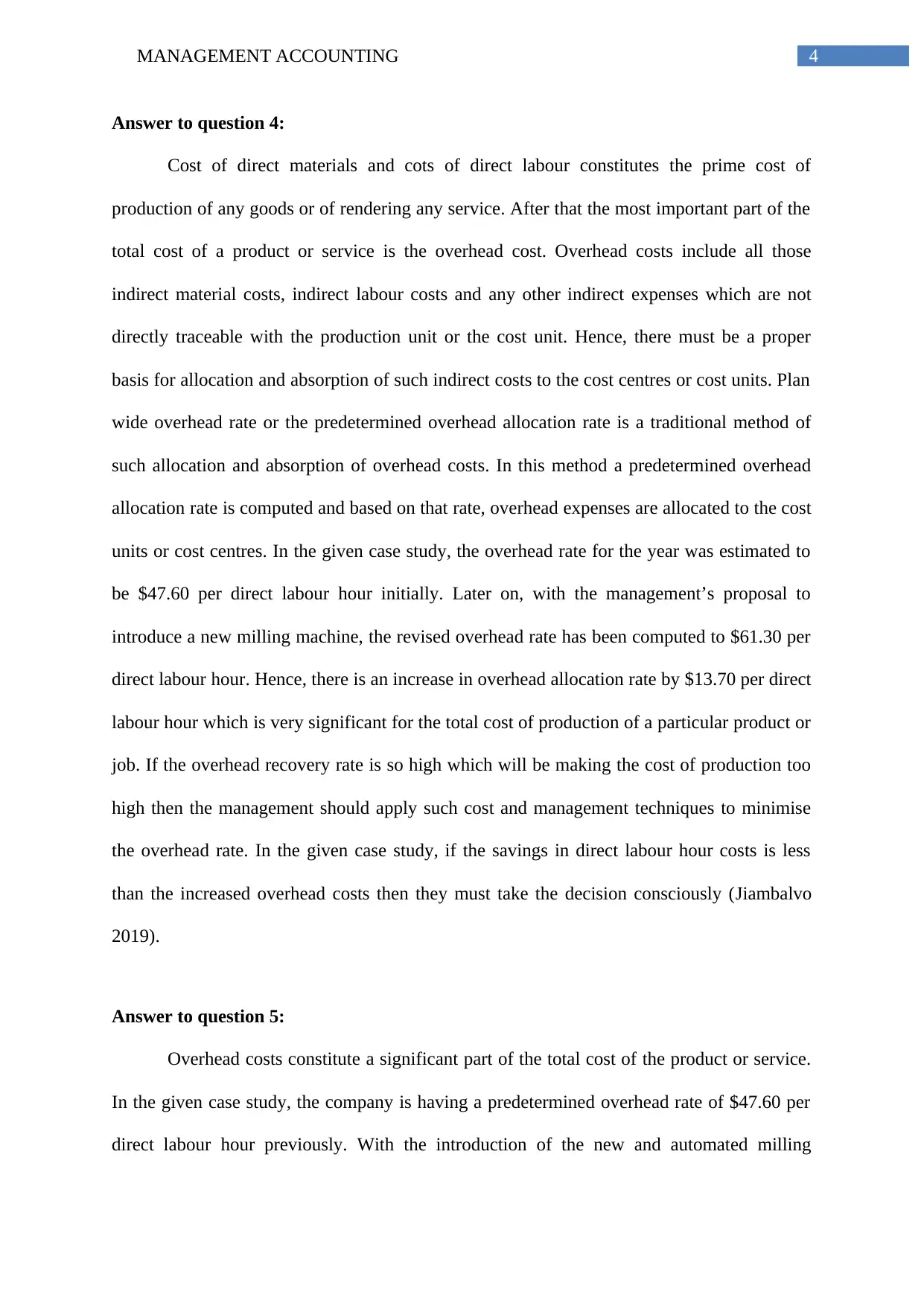
4MANAGEMENT ACCOUNTING
Answer to question 4:
Cost of direct materials and cots of direct labour constitutes the prime cost of
production of any goods or of rendering any service. After that the most important part of the
total cost of a product or service is the overhead cost. Overhead costs include all those
indirect material costs, indirect labour costs and any other indirect expenses which are not
directly traceable with the production unit or the cost unit. Hence, there must be a proper
basis for allocation and absorption of such indirect costs to the cost centres or cost units. Plan
wide overhead rate or the predetermined overhead allocation rate is a traditional method of
such allocation and absorption of overhead costs. In this method a predetermined overhead
allocation rate is computed and based on that rate, overhead expenses are allocated to the cost
units or cost centres. In the given case study, the overhead rate for the year was estimated to
be $47.60 per direct labour hour initially. Later on, with the management’s proposal to
introduce a new milling machine, the revised overhead rate has been computed to $61.30 per
direct labour hour. Hence, there is an increase in overhead allocation rate by $13.70 per direct
labour hour which is very significant for the total cost of production of a particular product or
job. If the overhead recovery rate is so high which will be making the cost of production too
high then the management should apply such cost and management techniques to minimise
the overhead rate. In the given case study, if the savings in direct labour hour costs is less
than the increased overhead costs then they must take the decision consciously (Jiambalvo
2019).
Answer to question 5:
Overhead costs constitute a significant part of the total cost of the product or service.
In the given case study, the company is having a predetermined overhead rate of $47.60 per
direct labour hour previously. With the introduction of the new and automated milling
Answer to question 4:
Cost of direct materials and cots of direct labour constitutes the prime cost of
production of any goods or of rendering any service. After that the most important part of the
total cost of a product or service is the overhead cost. Overhead costs include all those
indirect material costs, indirect labour costs and any other indirect expenses which are not
directly traceable with the production unit or the cost unit. Hence, there must be a proper
basis for allocation and absorption of such indirect costs to the cost centres or cost units. Plan
wide overhead rate or the predetermined overhead allocation rate is a traditional method of
such allocation and absorption of overhead costs. In this method a predetermined overhead
allocation rate is computed and based on that rate, overhead expenses are allocated to the cost
units or cost centres. In the given case study, the overhead rate for the year was estimated to
be $47.60 per direct labour hour initially. Later on, with the management’s proposal to
introduce a new milling machine, the revised overhead rate has been computed to $61.30 per
direct labour hour. Hence, there is an increase in overhead allocation rate by $13.70 per direct
labour hour which is very significant for the total cost of production of a particular product or
job. If the overhead recovery rate is so high which will be making the cost of production too
high then the management should apply such cost and management techniques to minimise
the overhead rate. In the given case study, if the savings in direct labour hour costs is less
than the increased overhead costs then they must take the decision consciously (Jiambalvo
2019).
Answer to question 5:
Overhead costs constitute a significant part of the total cost of the product or service.
In the given case study, the company is having a predetermined overhead rate of $47.60 per
direct labour hour previously. With the introduction of the new and automated milling
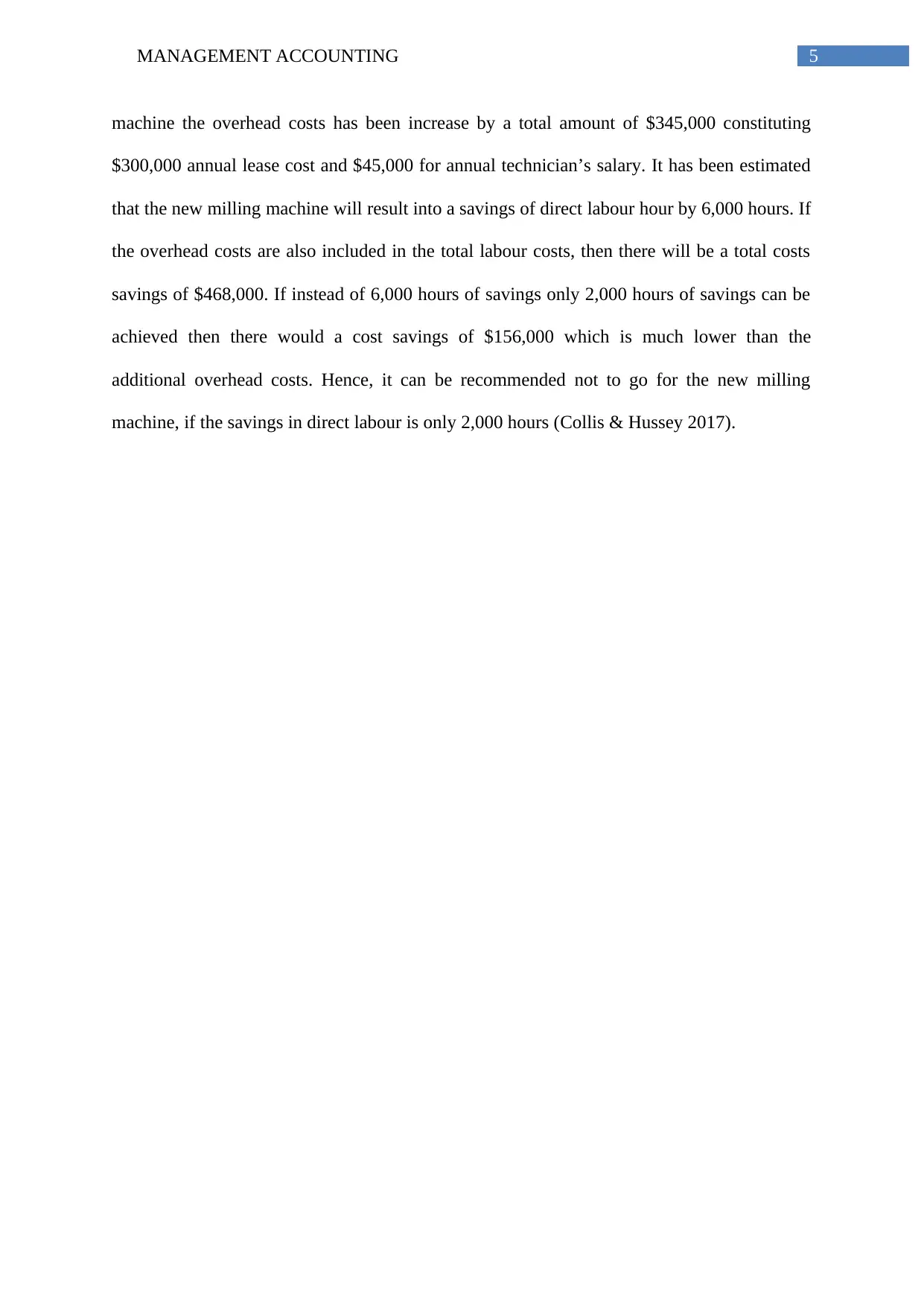
5MANAGEMENT ACCOUNTING
machine the overhead costs has been increase by a total amount of $345,000 constituting
$300,000 annual lease cost and $45,000 for annual technician’s salary. It has been estimated
that the new milling machine will result into a savings of direct labour hour by 6,000 hours. If
the overhead costs are also included in the total labour costs, then there will be a total costs
savings of $468,000. If instead of 6,000 hours of savings only 2,000 hours of savings can be
achieved then there would a cost savings of $156,000 which is much lower than the
additional overhead costs. Hence, it can be recommended not to go for the new milling
machine, if the savings in direct labour is only 2,000 hours (Collis & Hussey 2017).
machine the overhead costs has been increase by a total amount of $345,000 constituting
$300,000 annual lease cost and $45,000 for annual technician’s salary. It has been estimated
that the new milling machine will result into a savings of direct labour hour by 6,000 hours. If
the overhead costs are also included in the total labour costs, then there will be a total costs
savings of $468,000. If instead of 6,000 hours of savings only 2,000 hours of savings can be
achieved then there would a cost savings of $156,000 which is much lower than the
additional overhead costs. Hence, it can be recommended not to go for the new milling
machine, if the savings in direct labour is only 2,000 hours (Collis & Hussey 2017).
⊘ This is a preview!⊘
Do you want full access?
Subscribe today to unlock all pages.

Trusted by 1+ million students worldwide
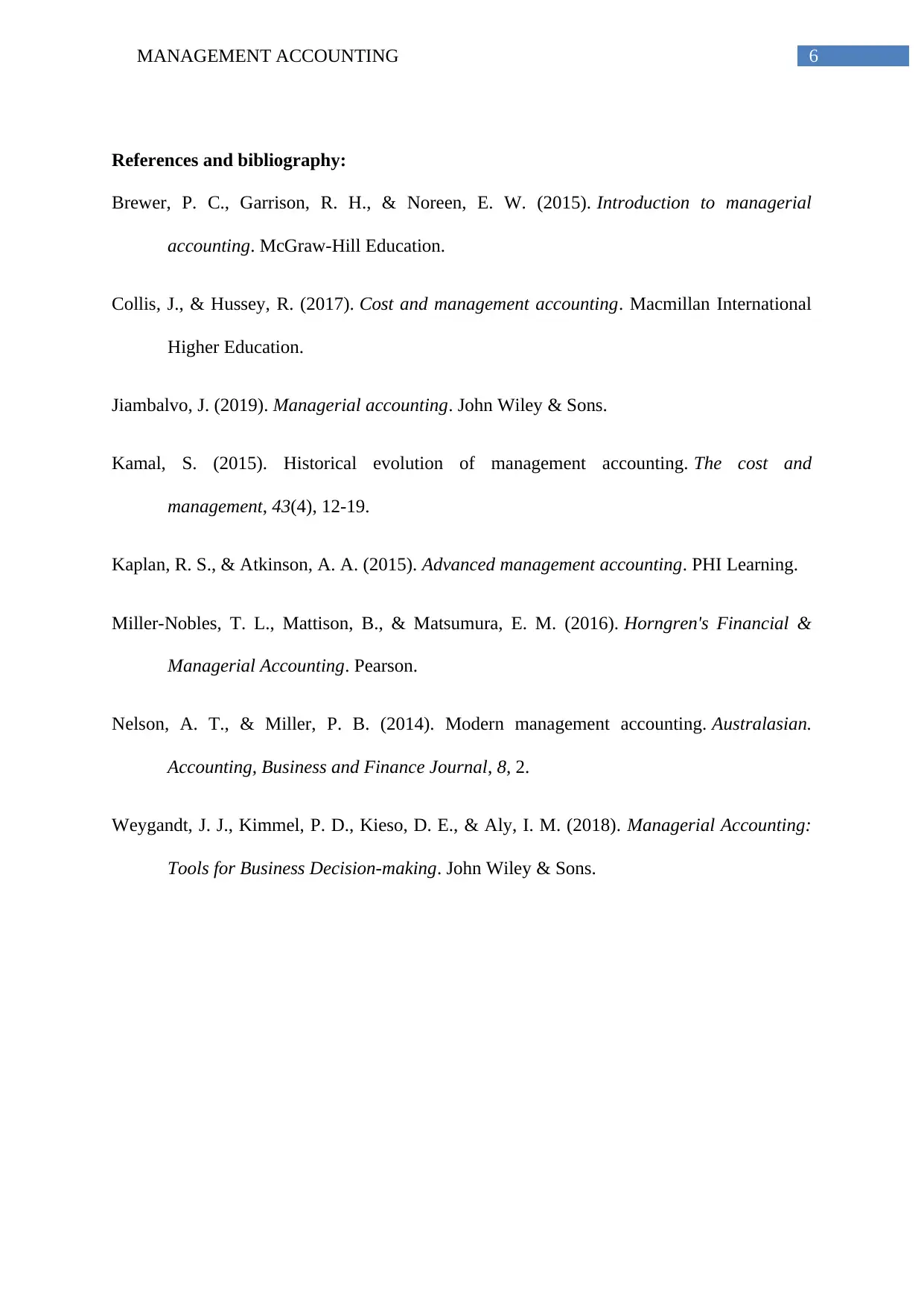
6MANAGEMENT ACCOUNTING
References and bibliography:
Brewer, P. C., Garrison, R. H., & Noreen, E. W. (2015). Introduction to managerial
accounting. McGraw-Hill Education.
Collis, J., & Hussey, R. (2017). Cost and management accounting. Macmillan International
Higher Education.
Jiambalvo, J. (2019). Managerial accounting. John Wiley & Sons.
Kamal, S. (2015). Historical evolution of management accounting. The cost and
management, 43(4), 12-19.
Kaplan, R. S., & Atkinson, A. A. (2015). Advanced management accounting. PHI Learning.
Miller-Nobles, T. L., Mattison, B., & Matsumura, E. M. (2016). Horngren's Financial &
Managerial Accounting. Pearson.
Nelson, A. T., & Miller, P. B. (2014). Modern management accounting. Australasian.
Accounting, Business and Finance Journal, 8, 2.
Weygandt, J. J., Kimmel, P. D., Kieso, D. E., & Aly, I. M. (2018). Managerial Accounting:
Tools for Business Decision-making. John Wiley & Sons.
References and bibliography:
Brewer, P. C., Garrison, R. H., & Noreen, E. W. (2015). Introduction to managerial
accounting. McGraw-Hill Education.
Collis, J., & Hussey, R. (2017). Cost and management accounting. Macmillan International
Higher Education.
Jiambalvo, J. (2019). Managerial accounting. John Wiley & Sons.
Kamal, S. (2015). Historical evolution of management accounting. The cost and
management, 43(4), 12-19.
Kaplan, R. S., & Atkinson, A. A. (2015). Advanced management accounting. PHI Learning.
Miller-Nobles, T. L., Mattison, B., & Matsumura, E. M. (2016). Horngren's Financial &
Managerial Accounting. Pearson.
Nelson, A. T., & Miller, P. B. (2014). Modern management accounting. Australasian.
Accounting, Business and Finance Journal, 8, 2.
Weygandt, J. J., Kimmel, P. D., Kieso, D. E., & Aly, I. M. (2018). Managerial Accounting:
Tools for Business Decision-making. John Wiley & Sons.
1 out of 7
Related Documents
Your All-in-One AI-Powered Toolkit for Academic Success.
+13062052269
info@desklib.com
Available 24*7 on WhatsApp / Email
![[object Object]](/_next/static/media/star-bottom.7253800d.svg)
Unlock your academic potential
Copyright © 2020–2025 A2Z Services. All Rights Reserved. Developed and managed by ZUCOL.





